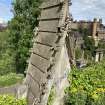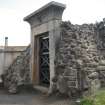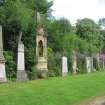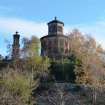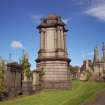Notice
Following a review of the Buildings at Risk Register we have paused the Register while we consider options for its future.
The website will remain accessible and searchable during this time, but it will not be updated and we’re not accepting nominations for additions to the Register. If you need to contact us about the BARR please email hmenquiries@hes.scot
Read the review report here and you can find out more about why we have paused the BARR on our news centre.
The Necropolis: Mausolea and Funerary Monuments, Cathedral Street, Glasgow
Ordnance Survey licence number AC0000807262. All rights reserved. © Copyright and database right 2025. Public Sector Viewing Terms
Useful Links
- Canmore:
- GLASGOW, GLASGOW NECROPOLIS
- Historic Scotland:
- HS Reference No 33890
- Historic Gardens & Landscapes:
- GDL00366
General Details and Location
Category
RESTORATION IN PROGRESS
Name of Building
The Necropolis: Mausolea and Funerary Monuments
Other Name(s)
Fir Park; Wishart Street; Merchants' Hill; Merchants' Park
Address
Cathedral Street, Glasgow
Locality
Postcode
Planning Authority
Divisional Area
Reference No
3152
Listing Category
A
OS Grid Ref
NS 60482 65549
Location Type
Urban
HS Reference No
33890
Description
The Necropolis is laid out on similar lines to Pere LaChaise, Paris and was opened May 1833. A major series of mausolea and monuments are dramatically sited on a steep hill overlooking the Cathedral, formed around Thomas Hamilton's statue of John Knox, 1825. (Historic Scotland)
The Necropolis was the third 'hygenic cemetery' in Britain (following Liverpool's St James, 1829 and London's Kendal Green, 1832) The idea of a garden cemetery, following the model of Pere LaChaise in Paris, had been proposed by a number of leading citizens to the Merchant's House in 1828, suggesting their plantation at Fir Park could be utilised for this commercial use.
The burial ground was intended to be interdenominational, and a Jewish burial ground was established on the north west slope in 1830. The following year a competition was held for the layout of the new cemetery. Although architects were initially appointed, instead the Merchant's House decided that a landscape gardener would be best suited to taking the design forward. George Mylne was subsquently appointed first Superintendant of the Necropolis.
Architectural features were professionally designed, as were many of the monuments, all of which would be vetted after 1835 to "prevent the construction of monuments in very bad taste". Proximity to the Knox monument was considered most prestigious, being sought after by leading families even after the extension of the cemetery to the east into a former quarry in 1857, and further east in 1894. (Williamson, Riches & Higgs)
50,000 burials have taken place at the Necropolis and most of 3,500 tombs have been constructed up to 14 feet deep, with stone walls and brick partitions. On the top of the Necropolis, tombs were blasted out of the rockface. The Necropolis contains monuments designed by major architects and sculptors of the time, including Alexander Thomson, Charles Rennie Macintosh and JT Rochead, in every architectural style, created for the prominent and wealthy entrepreneurs of the Second City of the Empire. (Ruth Johnston)
The Necropolis was the third 'hygenic cemetery' in Britain (following Liverpool's St James, 1829 and London's Kendal Green, 1832) The idea of a garden cemetery, following the model of Pere LaChaise in Paris, had been proposed by a number of leading citizens to the Merchant's House in 1828, suggesting their plantation at Fir Park could be utilised for this commercial use.
The burial ground was intended to be interdenominational, and a Jewish burial ground was established on the north west slope in 1830. The following year a competition was held for the layout of the new cemetery. Although architects were initially appointed, instead the Merchant's House decided that a landscape gardener would be best suited to taking the design forward. George Mylne was subsquently appointed first Superintendant of the Necropolis.
Architectural features were professionally designed, as were many of the monuments, all of which would be vetted after 1835 to "prevent the construction of monuments in very bad taste". Proximity to the Knox monument was considered most prestigious, being sought after by leading families even after the extension of the cemetery to the east into a former quarry in 1857, and further east in 1894. (Williamson, Riches & Higgs)
50,000 burials have taken place at the Necropolis and most of 3,500 tombs have been constructed up to 14 feet deep, with stone walls and brick partitions. On the top of the Necropolis, tombs were blasted out of the rockface. The Necropolis contains monuments designed by major architects and sculptors of the time, including Alexander Thomson, Charles Rennie Macintosh and JT Rochead, in every architectural style, created for the prominent and wealthy entrepreneurs of the Second City of the Empire. (Ruth Johnston)
Building Dates
circa 1825 onwards
Architects
Multiple
Category of Risk and Development History
Condition
Fair
Category of Risk
Low
Exemptions to State of Risk
Field Visits
October 2007, 15/11/2010, 26/7/2013, 29/06/2023
Development History
September 2007: External inspection reveals the monuments are collectively suffering from neglect. Many are marked as unsafe. The recurring problems are plant growth, collections of rubbish, deteriorating paintwork, stonework (especially of carved elements) decorative ironwork, and graffiti.
14 November 2007: Glasgow Evening Times reports on vandalism within the Necropolis. Quad bikes are reported to have been used in the site, damaging green areas. The article goes on to note the area is subject to ongoing anti-social behaviour at night. A trial lighting system to illuminate the Necropolis at night is due for implementation in October.
November 2010: Site visit finds the monuments and mausolea are broadly unchanged when compared to our visit in 2007. In some cases, such as the Robert Black mausoleum, planst are progressively damaging the structure. Graffiti on and rubbish inside mausolea remain unaddressed. A number of ornate gravestones have been toppled or broken into pieces.
January 2011: A Conservation Management Plan for the site has been drafted by Glasgow City Council in consultation with Historic Scotland. The report notes ongoing repair to the site. Between 2008-2010 over 200 headstones were reinstated by authorised contractors. Further phases have been identified for another 100 to be reinstated. The City Council hopes to identify once of the smaller mausolea for repair as a pilot project.
26 July 2013: External inspection finds an improvement in the condition of a number of monuments within the Necropolis. Restoration works continue.
18 October 2013: Historic Scotland advise that 5 of the mausolea have been repaired (Egyptian Vaults, Buchanan Sisters, King family, Black Mausoleum and Angus Turner) with fundraising for the repair of the Monteith Mausoleum underway. A programme of seperate repairs by Glasgow City Council is ongoing. Moved to Restoration in Progress.
30 January 2015: Glasgow City Council report GCC Land and Environment Services continue to undertake repair works at the site. To date 8 of 11 mausolea have been restored and many of the gravemarkers have also been restored. To date approximately 20% of the proposed repair work has been completed, further work is proposed in phases.
10 August 2015: Historic Scotland award £13,125 from their Building Repair Grant scheme towards the repair and restoration of 15 fallen headstones, a staircase and a rubble wall within the Jewish Enclosure of the Necropolis.
13 April 2017: Local planners advise the site remains the subject of a long-term conservation and management plan.
29 June 2023: External inspection finds that some works have been carried out as part of the long-term conservation project. The gates on several mausolea have been restored or replaced appropriately. The masonry of some mausolea, such as the Buchanans of Bellfield Mausoleum, also appears to be in better condition than noted in previous field visits. The Archibald Mausoleum Douglas Monteith Mausoleum remains in poor condition and is now surrounded by fencing with signage to discourage access. Vegetation and ivy growth remains a problem for some monuments and gravestones. The condition along smaller paths is poorer, with the decay of historic stairs and signs of vandalism to masonry of some of the mausolea. There are signs of anti-social behaviour in some areas, but the overall site appears to be maintained.
Guides to Development
Conservation Area
Central Area
Planning Authority Contact
PAC Telephone Number
0141 287 5492
Availability
Current Availability
Not Available
Appointed Agents
Price
Occupancy
Vacant
Occupancy Type
N/A
Present/Former Uses
Name of Owners
Glasgow City Council
Type of Ownership
Local Authority
Information Services
Additional Contacts/Information Source
Friends of Glasgow Necropolis http://www.glasgownecropolis.org
Bibliography
Buildings of Scotland Glasgow (1990) Williamson, Riches & Higgs p 138-141; Glasgow Necropolis, an Easy to Follow Guide Ruth Johnston (see Friends of Glasgow Necropolis)
Online Resources
Glasgow Necropolis Heritage Trail: http://www.glasgow.gov.uk/en/Residents/Parks_Outdoors/Heritage/HeritageTrails/GlasgowNecropolis/
Classification
Mausolea
Original Entry Date
03-OCT-07
Date of Last Edit
11/10/2023






